S. Ramani
The postage stamp is a flimsy thing
No thicker than a beetle’s wing
And yet it will roam the world for you
Exactly where you tell it to.
– EV Lucas
Postage stamps are unique outlets for countries to showcase important issues, raise public awareness and commemorate persons or events of national significance. Stamps are windows into the art and culture of nations, and they document the spirit of the time they were designed and published. Subjects represented on stamps are by nature wide and varied and stamp collecting is among the top pastimes. Most philatelists are thematic stamp collectors specializing in particular topics (Nezari, 2021).
Insects are a good subject for featuring on stamps, as for nearly 400 million years they have been the most dominant animal group on Earth and the most successful in evolutionary history. Designers of postage stamps have deemed insects worthy of prominence as stamp subjects, but insects started to appear on stamps much later than other larger and more attractive animals. If one flips through the pages of a stamp catalogue, it becomes apparent that insects are a popular theme (Pollock, 2000). Out of the 866 issuing entities 332 have issued stamps depicting insects. Of the 195 countries (recognized by the UN) only three – Myanmar, South Sudan and Timor-Lesthe – have not issued an insect themed stamp (Nezari, 2021).
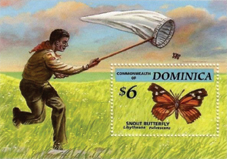
Miniature sheet featuring an entomologist collecting with a net; the snout butterfly on stamp
Entomophilately
Collectors of insect-related stamps are said to practice “entomophilately”. Insects are endlessly fascinating creatures that most people think of as nuisances or pests. The importance of insects to human welfare transcends the grand battles we fight against them to manage them for our own ends. Though some are bothersome, they are no less interesting to those who will stop and study them (Hamel, 1988). As uncommon philatelic subjects, they should find a ready welcome in anyone’s thematic collection.
For the past four decades, I have been collecting insects, with and without a net. The net-collected specimens are tucked away in neat rows in tidy, wooden drawers in insect museums. The bright colours of several insects, however, fade quickly and voids in the insect collection can be readily seen due to fungi, psocids and dermestids. This is when I began to see the appeal in filling album pages instead of display cases and my insects collected without a net, span the world of insects on stamps, whose charm and colour are everlasting. For those like me, who are both entomologically and philatelically inclined, the combination of both pursuits into entomophilately can be a very rewarding and educational hobby. It is amazing to see the numbers and variety of insect stamps that are being issued. More than 20,000 insect stamps have been issued worldwide by different stamp issuing entities depicting more than 2000 insects (Nezari, 2021).

The first image of a butterfly on a stamp
First insect stamps
The earliest postage stamp to feature insects was issued by Nicaragua in 1890. It depicted a small beehive along with the Goddess of Plenty. The first image of a butterfly on a stamp was issued in 1890 by Hawaii. The butterfly was in the hairpiece of Queen Liui-uokalani (1838-1917), the last reigning monarch of Hawaii.
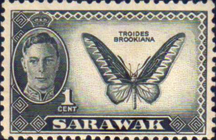
Raja Brooke’s bird wing,
Trogonoptera brookiana (Papilionidae)
The first taxonomically identifiable butterfly on a stamp was issued from Sarawak, Malaysia in 1950 representing a birdwing butterfly, Rajah Brooke’s birdwing (Troidesbrookiana) alongside King George VI’s portrait. This butterfly is found in the rainforests of the Thai-Malay peninsula, Borneo, Natuna, Sumatra and other islands. The butterfly was named by the naturalist Alfred Russel Wallace in 1855 after James Brooke, the Rajah of Sarawak. It is the national butterfly of Malaysia.
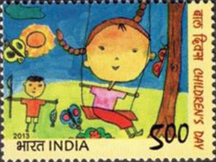
Children’s painting with butterflies
Insect stamps as teaching aids
Entomological stamps are a unique means of communication of science with the public and can be used as effective teaching tools (Turienzo, 2018). In addition to individual portrayals where an insect is the main theme of the stamp, insects also appear in various scientific contexts, including biodiversity, conservation, biological control, and diseases and their vectors. Insects also accompany portraits of famous entomologists, politicians, Nobel laureates, athletes and scouts (Nezari, 2021). Other popular themes in which insects have been incorporated include art, archaeology, astronomy, handicrafts, literature, music, etc. The remarkable diversity of insect stamps, the other themes represented and the various contexts in which insects appear on entomological stamps provide an excellent avenue to familiarize students with aspects of entomology in art, culture, science and everyday life around the world. Insect stamps thus provide a unique and valuable resource for educators (Nezari, 2021).
Insect taxonomy can also be taught using entomological stamps. The variety of stamps that have been issued by several countries with the scientific names can form a source of teaching insect classification and create an interest in young minds to pursue a hobby and also use it as an educational tool to learn about the several kinds of insects.
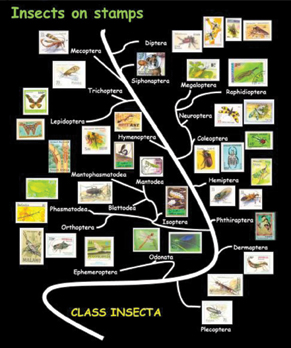
Diversity of insects on stamps
At least 24 of the 30 different orders of insects are represented on stamps. Butterflies and moths (Lepidoptera) are the champions as they appear on nearly two-thirds (69 per cent) of all insect stamps followed by Coleoptera (9 per cent) and Hymenoptera (9 per cent). Some orders like Embioptera (web spinners) and Thysanoptera (thrips) have not been represented on stamps at all while orders like Megaloptera (alderflies, dobsonflies, fishflies) and Raphidioptera (snakeflies) have been depicted only once so far. With 15 orders depicted, Mozambique has most widely represented insects on stamps. The countries with a greater number of entomological stamps are Guinea (799), Guinea-Bissau (651) and Sao Tome Principe (611) (Nezari, 2021).
The above image depicts a few insect orders that have featured on stamps with representative stamps issued by different countries for each order.
Representative stamps that have been issued for five insect orders are presented here with brief characteristics of the order. Teachers and students can undertake the study of other insect orders (refer to the image) represented on stamps as projects and look to collect information and stamps of the insect order they are studying.
1. Odonata: Commonly called dragonflies and damselflies, their young, called nymphs, are aquatic. Both nymphs and adults are predaceous. The order contains about 6300 species. At least 148 countries have issued about 650 stamps on 250 species.

2. Orthoptera: Comprises of grasshoppers, locusts and crickets. The order contains more than 20,000 species and is distributed worldwide. They produce sound by stridulation, rubbing their wings against each other or their legs over the wings. They have been featured on nearly 350 stamps.
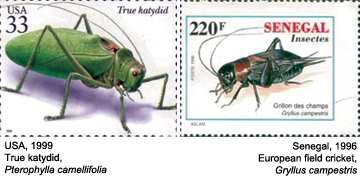
3. Coleoptera: This is the largest order with about 400,000 described species, constituting 40 per cent of insects and 25 per cent of all animal life-forms. Their front pair of wings are hardened into wing-cases called elytra. They undergo complete metamorphosis and are found in almost every habitat. Beetles have featured on nearly 1800 stamps.

4. Lepidoptera: It is one of the most widespread and widely recognizable insect orders of the world. Butterflies and moths with their different shapes, sizes, colours and habits are fascinating and beautiful creations of nature. About 180,000 species of Lepidoptera have been described making up 10 per cent of the total described species of living organisms. Lepidoptera is the most recognized and popular of insect orders. Nearly 14150 stamp issues have featured the lepidopterans. Highest number of species of Papilionidae (53.5 per cent) have been depicted on stamps while the Monarch butterfly (Danaus plexippus) with 290 depictions is the most common species on stamps. Despite their dominance only 2 per cent of the Lepidoptera species have been represented on stamps (Nezari, 2021).
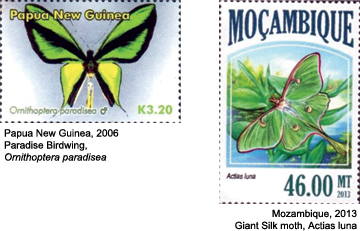
5. Hymenoptera: This large order of insects comprises the sawflies, wasps, bees and ants. The winged forms have membranous wings and the hindwings are connected to the forewings by a series of hooks. Females usually have a hardened ovipositor, which may be modified for sawing, piercing or stinging. The mouth parts may either be of the biting type or of the biting-sucking type. Over 150,000 species have been described. Nearly 1900 stamps featuring insects from this order have been issued and among them, honeybees (31.2 per cent) are the most prevalent depiction.
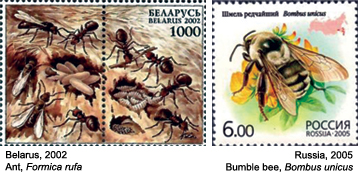
Entomologists on stamps
Stamps have also portrayed several entomologists on them. Here are two – Jean Henri Fabre and Ronald Ross.
Jean Henri Fabre (1823-1915) was a French entomologist known for the lively style of his popular books on insects. He is considered by many to be the father of modern entomology. France issued a First Day Cover (FDC) and a stamp on him in 1956.
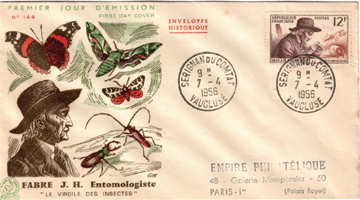
FDC with illustration depicting J.H. Fabre and some lepidopterans and beetles
Stamp: J.H. Fabre examining Great Peacock moth, Saturnia pyri with a magnifying lens. Other insects on stamp are European mantis, Mantis religiosa, Sacred scarab, Scarabaeus sacer and Common cicada, Lyristes plebejus
Sir Ronald Ross (1857-1932) was a British medical doctor in the Indian Medical Service, who did extensive research on the transmission of malaria. During 1895-97, while working in Calcutta Presidency General Hospital, he found that the malarial parasite is stored in the salivary glands of the mosquitoes and is transmitted through the bite of the female mosquito. Sir Ross was awarded the Nobel Prize in 1902 for his work. A stamp on him was released by India Post in 1997 marking the centenary of the discovery of the malarial parasite.
Insect stamps from India
The first stamp on an insect in India was issued in 1955 on Malaria control depicting a major vector of malaria, Anopheles culifacies followed by another in 1962 with the Malaria Eradication Emblem and Anopheles sp. coinciding with the declaration by WHO of 1962 as World Malaria Year to raise awareness about the disease and as part of the fight against malaria.
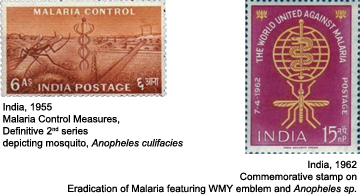
The first stamps featuring Lepidoptera from India were released in 1981 and consisted of four stamps on butterfly species endemic to the Indian subcontinent. They are: Northern Jungle Queen, Stichophthalmia camadeva (Nymphalidae) found in North Bengal, Assam, Manipur, Nagaland and Sikkim; Red Lace Wing, Cethosia biblis (Nymphalidae) found in Assam, Sikkim, North Bengal, Mizoram, Arunachal Pradesh, Nagaland, Manipur, Meghalaya and Andaman and Nicobar Islands; Map Butterfly, Cyrestis achates (Nymphalidae) a widespread species in India; Kaiser-i-Hind, Teinopalpus imperialis (Papilionidae) found in Sikkim, Assam, West Bengal, Meghalaya and Manipur.
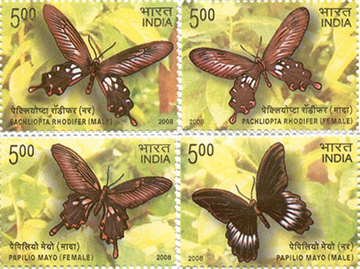
Endemic Butterflies of Andaman and Nicobar Islands
Andaman Clubtail, Losaria rhodifer (male and female)
Andaman Mormon, Papilio mayo (male and female)
Eight species of butterflies are endemic to the Andaman and Nicobar Islands of which two species belonging to the family Papilionidae, Andaman Mormon, Papilio mayo and Andaman Clubtail, Losaria rhodifer, were portrayed on four stamps released in 2008. Andaman Clubtail, Losaria rhodifer is a rare endemic species of the islands. It is unpalatable to predators. Andaman Mormon, Papilio mayo, is the first endemic butterfly described from the islands and the name honours Richard Bourke, the 6th Earl of Mayo, who was assassinated in 1872, a year before the butterfly was discovered. The female mimics the unpalatable Andaman Clubtail.
Ladybird beetles (Coccinellidae) are commonly yellow, orange, or red with small black spots on their wing covers. This group of insects is very popular on stamps from different countries. A set of four stamps on ladybird beetles was released in 2017. It would have been apt to give the scientific names of the species instead of just mentioning ‘Ladybird beetle’ on each stamp. None of these are truly native species of Indian origin, though over 600 species of ladybird beetles are known from India (Ramani, 2017).
Panaji Philatelic Bureau, Goa recently issued 10 maxim cards with a presentation pack on the butterfly and moth diversity of Goa and a pictorial cancellation in 2021 coinciding with the state level philatelic exhibition, Goapex 2021. The speciality of these cards is that the QR code given on the card will link you to the Wikipedia site for the species depicted.
Another interesting release in 2022 was a Permanent Pictorial Cancellation on a postcard released again by the Goa Postal Division featuring the state butterfly of Goa, the Malabar Tree Nymph butterfly, Idea malabarica. It is the first of the kind augmented reality cancellation that comes with a QR code that leads to the link of the app and lets you enjoy the flight of the butterfly.
Conclusion
There are several important sources that can help in collecting stamps on insects. There are different world stamp catalogues, the most popular of which are Michel, Scott, Stanley Gibbons, and Yvert and Tellier. There exist several more specific stamp catalogues for insect issues, including: Domfil Thematic Stamp Catalogue, 1996. Butterflies and Other Insects, Sabadell, Spain; Hamel, D.R. 1991. Atlas of Insects on Stamps of the World. Tico Press, Falls Church, VA, USA; Wright, D.P., 1993, 2005, 2014 Insects on Stamps of the World. American Topical Association Handbook No. 123, 150, 164 and several internet sites that deal with insect stamps.

Insect stamps have been issued to celebrate useful insect species, alert us to the battles against the harmful ones, or simply to portray the varied and wondrous shapes and colours of insects. Insects are closely associated with human beings and several human enterprises like agriculture, sericulture, beekeeping, etc. Several aspects of insects can be promoted like their diversity, characteristics, life traits, behaviour, association with human beings, benefits derived from them, the need to conserve them and above all their innate beauty (Pollock, 2000). From a point of view of thematic philately, insects can form a fascinating study and several sub themes like butterflies, beetles, bugs, dragonflies, bees, malaria, etc., can be chosen, and each of them will provide you interesting ways of appreciating insects and their role in our lives. Entomophilately can turn out be a very rewarding and educational hobby.
Admire insects on stamps. Do not stamp them out.
References
• Hamel, D.R. 1988. Insects on stamps. Topical Time, March-April, 1988, American Topical Association, 20-26.
• Nezari, V. 2021. Taxonomy at face value: an assessment of entomological postage stamps as effective teaching aids for science educators. Research Ideas and Outcome, 7:e68056. https://doi.org/10.3897/rio.7.368056
• Pollock, D.A. 2000. Insects on Stamps – Good guys and Bad guys. Newsletter, The Entomological Society of Manitoba, 27 (2): 1-4.
• Ramani, S. 2017. The Passions and Requests of an Earnest Entomophilatelist. The Wire, 19 November, 2017. https://thewire.in/science/passions-requests-earnest-entomophilatelist
• Turienzo, P. 2018. Teaching Entomology with postage stamps as didactic resource. IDESIA (Chile), 36: 119-129
The author works with the Department of Entomology, University of Agricultural Sciences, Gandhi Krishi Vigyan Kendra, Bengaluru. He can be reached at ramanisrinivasan55@gmail.com.
